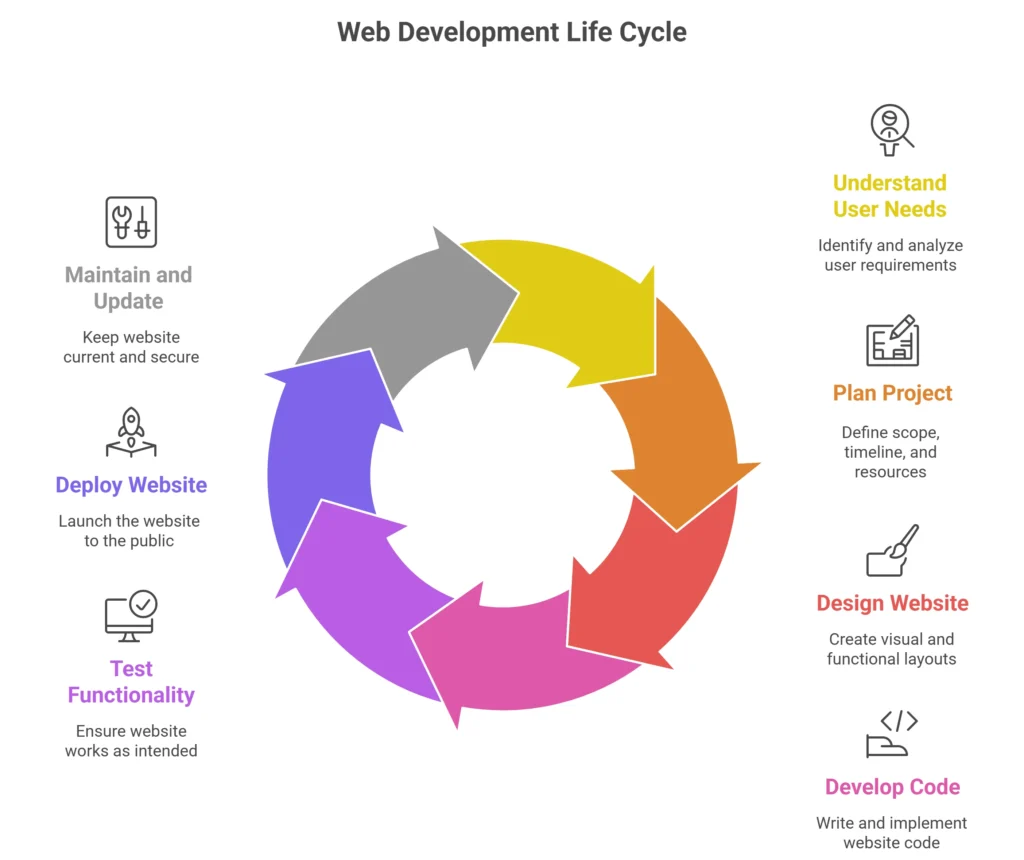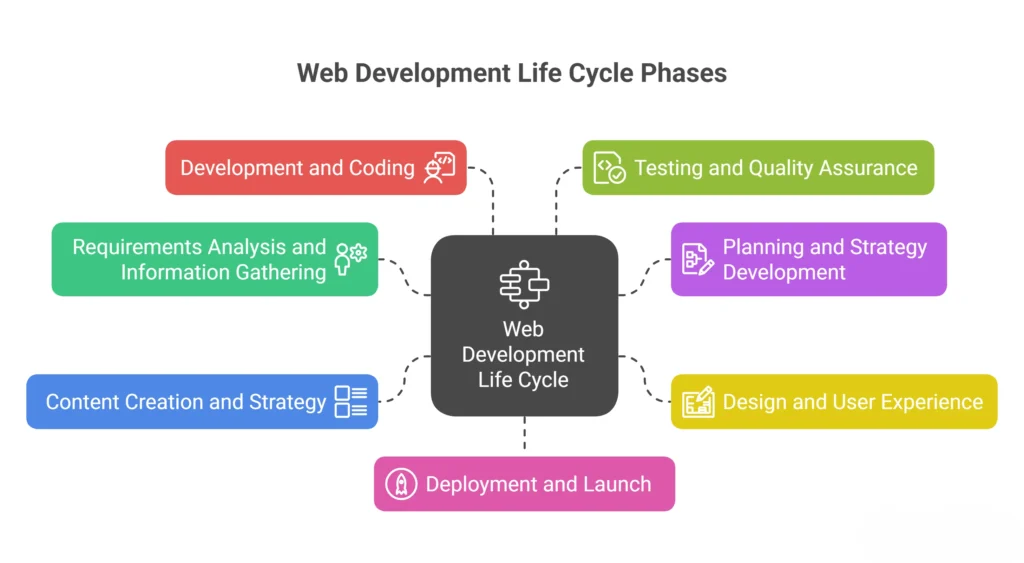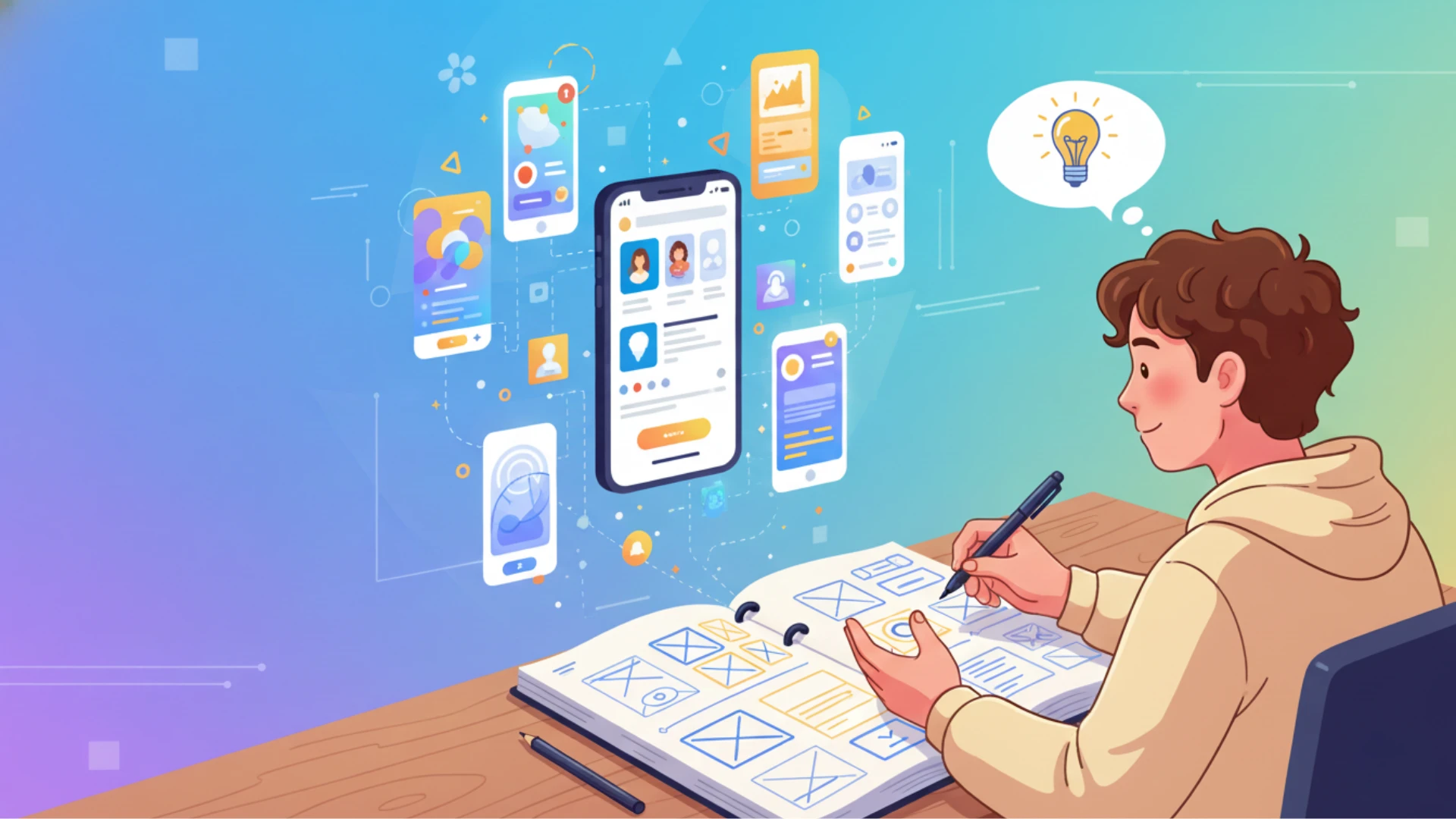Mastering the web development life cycle is no longer optional, it’s the foundation for building high-performing digital experiences in 2025. Whether you’re launching a new site or revamping an old one, understanding this structured process can help avoid costly missteps.
Moreover, with over 1.13 billion websites live today and user expectations at an all-time high, businesses can’t afford to treat web development as a one-off project.
A methodical approach, starting from discovery to post-launch optimization, sets the tone for success, scalability, and ROI-driven outcomes.
Therefore, in this blog, we’ll walk you through the 7 core phases of the website development cycle, how they’ve evolved in 2025, and the tools, strategies. Furthermore, we will look at the best practices that can make or break your next project.
What is the Web Development Life Cycle (WDLC)?

Building a website isn’t just about design and code. It’s about mapping a journey, one that starts with an idea and leads to a fully functional online presence.
That journey has a name:
- The web development life cycle.
It’s the strategic process that brings structure, clarity, and direction to web projects of every size. Each phase in this life cycle plays a unique role. From understanding the user’s needs to deployment and beyond, following a defined roadmap reduces chaos and helps teams collaborate better.
Furthermore, it also creates the kind of momentum that turns ideas into websites that work and scale.
At its core, WDLC stands for a structured and collaborative approach to website creation. The goal? Make each stage from planning to testing run smoothly, without skipping vital steps. It’s all about being clear on what needs to be done, who’s doing it, and when.
Why Following WDLC is Essential for Project Success
No matter how big or small a web project is, structure matters. The web development life cycle ensures nothing is rushed or left out. It improves consistency, speeds up delivery, and boosts performance across every touchpoint.
Additionally, teams that use web development methodology are more likely to meet business goals and exceed user expectations.
WDLC vs Traditional Software Development
Unlike traditional software models, WDLC is faster and more flexible. It’s often built on agile or iterative methods that allow teams to adjust on the go.
While desktop software may follow a strict release plan, websites benefit from continuous updates, user testing, and live feedback.
The 7 Phases of Web Development Life Cycle

Before diving into development, a clear structure sets the foundation. Let’s explore how each phase of the web development life cycle builds toward a seamless and successful digital product.
Phase 1: Requirements Analysis and Information Gathering
Before any line of code is written, a successful web development life cycle begins with detailed discovery. This is often the first step of the comprehensive web development services.
It is about aligning business objectives with user expectations through structured research and stakeholder collaboration.
- Stakeholder Interviews and Business Goals
This step involves direct conversations with business owners, department leads, and project sponsors to clearly outline key objectives. Through these interviews, teams can identify both short-term and long-term goals, ensuring that the website aligns with measurable outcomes and serves the intended business purpose effectively.
- Target Audience Research and User Personas
Understanding your audience is critical. During this web development life cycle stage, market research, surveys, and data analytics are used to create realistic user personas. These profiles help guide design, content, and feature decisions, ensuring the final product appeals to the people it’s built for.
- Functional and Non-Functional Requirements
Teams now define what the website must do (functional) and how it should perform (non-functional). This includes aspects like login systems, load speed, uptime, and compliance. Clarifying these expectations early reduces ambiguity and guides the technical strategy throughout development.
- Project Scope and Constraint Definition
To prevent scope creep, this step formalizes what will and will not be part of the project. It also identifies constraints such as time, budget, and resource availability. Defining these parameters early in the web development life cycle helps manage expectations and avoids unnecessary delays later.
Phase 2: Planning and Strategy Development
Once requirements are defined, the next step in the web development life cycle is crafting a detailed plan that brings structure to the execution. This phase ensures clarity on timelines, technologies, team responsibilities, and potential roadblocks before development begins.
- Project Roadmap and Timeline Creation
Creating a visual roadmap helps all stakeholders stay aligned. It outlines key milestones, deliverables, and deadlines. Thus, giving the team a shared sense of direction. Charts or project management tools are often used to break the project into manageable sprints or phases.
- Technology Stack Selection
Secondly, the right technology stack forms the backbone of the web development life cycle. Based on the site’s goals and complexity, developers choose frontend frameworks, backend languages, databases, and hosting environments. As a result, this choice also influences scalability, maintenance, and future integration capabilities.
- Resource Allocation and Team Structure
During this step of the web development life cycle, roles and responsibilities are assigned across designers, developers, content creators, and project managers. Why? Because efficient resource planning ensures that tasks are distributed logically and that dependencies are managed without bottlenecks during development.
- Risk Assessment and Mitigation Strategies
Every web project comes with uncertainties. Therefore, identifying potential risks like delayed feedback, security issues, or third-party dependency failures is crucial. Furthermore, creating contingency plans and communication protocols minimizes disruptions and prepares the team for unexpected changes.
Phase 3: Design and User Experience
A great-looking website isn’t enough. To truly engage visitors, every interaction must feel intuitive, consistent, and on-brand. That’s where this web development life cycle phase plays a pivotal role. It turns plans into a visually compelling and user-friendly experience. Here’s how:
- Wireframing and Prototyping
First and foremost, wireframing acts as the skeletal foundation of your future site. It defines structure, placement, and user flow before design elements are layered on top. Moreover, prototypes take it a step further, adding interactivity so stakeholders can experience real-time navigation. Thus, making it easier to spot friction points early on.
- Visual Design and Branding Integration
This is where imagination meets identity. Designers incorporate visual assets that reflect your brand’s voice like colors, typography, and iconography while maintaining functionality. In doing so, the web development life cycle assures a cohesive aesthetic that builds trust with visitors from their very first click.
- Responsive Design and Mobile Optimization
In today’s multi-device world, your site must work flawlessly across all screen sizes. Therefore, responsive design isn’t optional, it’s essential. By applying flexible grids and CSS media queries, developers guarantee that your website remains legible, fast, and user-friendly on smartphones, tablets, and desktops alike.
- Accessibility and Usability Considerations
Lastly, inclusivity shouldn’t be an afterthought. Ensuring your site meets WCAG guidelines allows everyone, including users with disabilities, to engage without barriers. From ARIA labels to high-contrast design, this step in the web development life cycle guarantees that accessibility and usability are deeply embedded, not just tacked on.
Phase 4: Content Creation and Strategy
Design may catch the eye, but it’s content that holds attention and drives action. In this phase, teams align messaging, structure, and tone to serve both users and search engines. Thus, this step certifies that words and visuals work in tandem to deliver value, clarity, and engagement throughout the web development life cycle.
- Content Architecture and Information Hierarchy
Organizing content effectively is the backbone of a successful website. Clear hierarchy helps users find what they need quickly. Hence, improving satisfaction and reducing bounce rates. This means grouping similar information together, labeling sections meaningfully, and prioritizing what’s most important, so visitors can absorb your message at a glance.
- SEO-Optimized Content Development
Optimizing content for search used to be only about stuffing keywords but now, it’s about answering the right questions in the right way. Using tools like keyword research, search intent analysis, and on-page SEO best practices, this step helps your content rank well while staying readable and valuable. Done right, it fuels organic traffic and keeps your brand visible throughout the web development life cycle.
- Multimedia Integration and Asset Management
Next, words alone can’t tell the full story. Integrating videos, images, infographics, and animations helps convey complex ideas quickly and memorably. But this must be done thoughtfully. Every asset needs to be optimized for speed, tagged for SEO, and stored efficiently for long-term use.
- Content Management System (CMS) Selection
Choosing the right CMS depends on your team’s tech skills, goals, and future plans. Whether you opt for WordPress, Drupal, or a headless CMS like Strapi, the goal is to make publishing and editing content easy without relying on developers. Therefore, a well-chosen CMS supports long-term scalability and ensures content agility as your website evolves.
Phase 5: Development and Coding
This phase turns ideas and visuals into a working digital experience. It’s where the technical architecture is built, interactions come to life, and the foundation of performance and scalability is laid. Thus, making it a defining part of the web development life cycle.
- Frontend Development Technologies and Frameworks
Front-end development brings the design to life using technologies like HTML5, CSS3, and JavaScript frameworks such as React, Vue, or Angular. These tools define how users interact with your website across devices. Moreover, ensuring lightweight code, component reuse, and responsiveness is essential for delivering a seamless user experience.
- Backend Development and Database Integration
Now let’s talk about the backend. The backend is the unseen engine powering your site. Developers use server-side languages like Node.js, PHP, or Python to create logic, handle data, and connect to databases. A robust backend setup ensures secure user authentication, fast content delivery, and scalable architecture that grows with your business.
- API Development and Third-Party Integrations
To expand functionality, many modern websites rely on APIs and external services. From integrating payment gateways to CRMs or analytics platforms, this step connects your ecosystem. Also, well-documented, secure APIs enhance flexibility without compromising performance or security, giving your site room to evolve.
- Version Control and Code Management
Version control systems like Git keep track of every code change, enabling teams to collaborate smoothly and roll back errors when needed. Code repositories such as GitHub or Bitbucket provide centralized environments for testing, review, and release cycles. As a result this makes them essential tools in the web development life cycle for professional code management.
Phase 6: Testing and Quality Assurance
Before any website goes live, it must be rigorously tested for quality, performance, and compatibility. Within the web development life cycle, testing acts as the final gatekeeper between development and deployment.
Therefore, this phase ensures that all features work as intended, no bugs sneak through, and users get a polished, professional experience.
- Types of Testing in Web Development
Firstly, testing goes far beyond just clicking through a few pages. It includes unit testing for individual components and regression testing to ensure new updates don’t break old functionality. As a result, these layers certify that the site remains stable under various use cases and business logic scenarios.
- Cross-Browser and Device Compatibility Testing
Websites need to perform consistently across a wide range of browsers and devices. Therefore, this web development life cycle step checks rendering on Chrome, Safari, Edge, and Firefox, as well as on tablets and smartphones. Testing responsiveness and layout integrity ensures no customer is alienated because of their browser choice or screen size.
- Performance and Security Testing
No user sticks around if your site loads slowly. Performance testing identifies speed bottlenecks, optimizes loading time, and assures that assets like images and scripts don’t weigh down the experience. At the same time, security testing detects vulnerabilities, validates encryption practices, and helps fortify the site against external threats, all critical for a dependable web development life cycle.
- User Acceptance Testing (UAT)
Last but not least, UAT involves letting stakeholders or actual users explore the site before launch. Their feedback reveals gaps developers may overlook like confusing navigation, broken links, or poor content clarity. Moreover, final tweaks based on this input can significantly enhance usability and help ensure that expectations are met across the board.
Phase 7: Deployment and Launch
This is the moment where all the planning, designing, and testing finally pay off. Deployment marks the official transition from development to a live product accessible by users. A smooth launch is a crucial milestone in the web development life cycle. Hence, it requires careful preparation, coordination, and post-launch monitoring.
- Server Setup and Hosting Configuration
Choosing the right hosting provider is essential for speed, uptime, and scalability. During this step, developers configure the server environment, set file permissions, and deploy the production build. In addition, the hosting setup must align with the site’s performance goals and expected traffic to avoid unexpected crashes or slowdowns once live.
- Domain Registration and DNS Management
A professional web presence begins with a properly registered domain and correctly configured DNS records. This phase involves pointing the domain to the live server, setting up subdomains if needed, and ensuring everything propagates globally without issues. Also, clear DNS setup ensures that users can reliably reach your site, without lag or misdirection.
- SSL Certificate Installation and Security
Security doesn’t end at development, it must carry into deployment. Installing an SSL certificate encrypts data exchanged between your server and users, enhancing trust and protecting sensitive information. Moreover, from HTTPS redirection to certificate renewals, this step is foundational for any modern website’s credibility and is non-negotiable in the web development life cycle.
- Go-Live Checklist and Launch Strategy
Lastly, a go-live plan acts as your safety net. It includes a final pre-launch audit of broken links, SEO setup, error logs, backups, and performance tracking tools. Once everything checks out, a coordinated launch ensures minimal downtime. After going live, active monitoring and analytics setup help fine-tune the site based on real-user behavior.
Post-Launch: Maintenance and Continuous Improvement
Just because your website is live doesn’t mean the journey is over. In fact, this is where the real relationship with your audience begins.
A successful web development life cycle doesn’t end at deployment, it evolves through updates, feedback, and growth. Your website is a living system, and it deserves ongoing care.
- Regular Monitoring and Performance Optimization
Think of your website like a car, it runs smoothly with regular tune-ups. Post-launch, you’ll want to keep an eye on page speed, server load, and uptime. Furthermore, tools like Google PageSpeed Insights or Lighthouse help spot trouble areas early. Performance optimization isn’t glamorous, but it’s vital for delivering a fast, frustration-free user experience.
- Bug Fixes and Feature Enhancements
Secondly, no launch is ever truly perfect. Small bugs will surface as real users interact with your site in unexpected ways. Instead of seeing this as a flaw, treat it as an opportunity. Therefore, prioritize fixes quickly, and log user requests for future features. This is a natural extension of the web development life cycle, responding, refining, and evolving.
- SEO and Content Updates
Search engines love fresh content and well-optimized pages. Keep tweaking your keywords, adding blog posts, or updating outdated information. Remember: your content strategy doesn’t pause once the site is live. By consistently refreshing your SEO, you not only maintain visibility, you become more discoverable as your brand matures online.
- User Feedback and Iterative Improvements
Also, the most valuable insights often come from the people using your site daily. Whether it’s a customer pointing out a usability issue or a colleague suggesting a new feature, this feedback drives true improvement. Therefore, building space for iteration into your web development life cycle assures that your site keeps up with your goals and your users’ needs.
Technologies and Tools in Web Development Life Cycle
Behind every great website is a set of powerful tools working seamlessly together. From the visuals users interact with to the logic behind the scenes, the web development life cycle relies on a mix of technologies to bring ideas to life. Let’s take a closer look at the essentials.
- Frontend Technologies (HTML, CSS, JavaScript, React, Angular)
This is where design meets interaction. HTML structures the content, CSS styles it beautifully, and JavaScript brings it to life with interactivity. Also, modern frameworks like React and Angular take things even further by enabling dynamic, fast-loading interfaces. These technologies shape the first impression users get and help keep them engaged.
- Backend Technologies (PHP, Python, Node.js, Java)
While the front end handles the look, the backend handles the logic. PHP powers many content-heavy platforms, Python offers flexibility and readability, Node.js supports real-time applications, and Java stands strong for scalable systems. As a result, these technologies quietly power your application’s brain, handling data, logic, and integrations with impressive reliability.
- Database Management Systems
Data is the backbone of almost every web application. From user logins to product listings, storing and managing data efficiently is non-negotiable. Tools like MySQL, PostgreSQL, MongoDB, and Firebase each bring something unique to the table. Therefore, choosing the right one depends on your project’s needs, structure, and future scalability.
- Development and Testing Tools
No web development life cycle is complete without solid tools for writing, testing, and deploying code. VS Code, Git, GitHub, Postman, Selenium, and CI/CD pipelines help teams collaborate, automate testing, and ship error-free updates. Thus, these tools not only save time but also ensure that quality doesn’t take a back seat to speed.
Best Practices for Effective Web Development Life Cycle
Executing a successful project is not just about technical skill, it’s about how the team operates. The web development life cycle thrives when guided by proven best practices that encourage flexibility, communication, and consistent quality. Here’s what that looks like in action.
- Agile vs Waterfall Methodologies in Web Development
The choice between Agile and Waterfall can shape the project’s trajectory. Agile emphasizes adaptability, great for evolving goals while Waterfall follows a linear, step-by-step approach. So, understanding when to use each can greatly improve project efficiency. For modern, iterative environments, Agile usually aligns better with the web development life cycle.
- Communication and Collaboration Strategies
Even the best code won’t matter if teams don’t talk. Tools like Slack, Jira, and Notion support real-time updates, while regular check-ins keep everyone aligned. Furthermore, transparent communication helps avoid misunderstandings and fosters a culture of collaboration where ideas are openly shared and issues are quickly resolved.
- Documentation and Knowledge Management
Projects evolve, and without proper documentation, so can confusion. Maintaining clear, concise records from system architecture to user flows, assures that team members (old or new) can pick up where others left off. It’s not glamorous, but it’s essential for long-term stability in the web development life cycle.
- Quality Control and Code Review Processes
Last-minute fixes and rushed launches often come back to bite. That’s where quality control steps in. Code reviews, peer checks, and automated testing routines help catch issues early and keep standards high. Over time, these habits not only prevent bugs but also encourage a culture of craftsmanship.
Common Challenges and How to Overcome Them
Even with the best planning, no project is immune to hurdles. From shifting goals to internal miscommunication, the web development life cycle can get derailed without proactive strategies. Below are some of the most common obstacles and how to get past them with confidence.
- Scope Creep and Requirements Changes
What begins as a clear list of deliverables can quickly spiral. Clients often request new features mid-project, leading to what’s known as scope creep. The solution? Establish a formal change request process early on. This way, your team can assess impact, prioritize correctly, and maintain control throughout the web development life cycle.
- Timeline and Budget Management
Deadlines slip and budgets stretch when estimates aren’t realistic. To prevent this, build in time buffers and account for unexpected delays. Tools like Gantt charts or agile sprints can offer visibility and help keep everything on track.
Most importantly, revisit your estimates periodically and communicate changes transparently. Luckily, the cost of web development in India is on the lower part despite the high output quality.
- Technical Debt and Code Quality Issues
Quick fixes today can become roadblocks tomorrow. That’s the nature of technical debt. To avoid it, prioritize clean coding standards, refactoring schedules, and regular code reviews. Moreover, investing in these practices not only improves maintainability but also reduces bugs, strengthening your overall web development life cycle from a technical standpoint.
- Team Coordination and Communication Gaps
Distributed teams and busy calendars often lead to fragmented communication. A shared task board or centralized project hub (like Notion or Trello) can help everyone stay on the same page. Additionally, weekly stand-ups and retrospectives further bridge gaps. Thus, making collaboration smoother and preventing missed dependencies.
Measuring Success in Web Development Projects
Once your site is live, the real work of measurement begins. From performance metrics to user satisfaction, understanding how to gauge success is essential for every web development life cycle project.
- Key Performance Indicators (KPIs) for Web Projects
Success starts with clear metrics. Think bounce rates, conversions, and traffic quality. These help assess whether your site meets its strategic goals while also highlighting areas needing refinement. You don’t just track for the sake of it, you track to optimize. Check out this Web development project KPIs guide for a deeper dive.
- Project Timeline and Budget Adherence
A project might be successful creatively, but if it runs over time or budget, the impact is diluted. Therefore, tracking deliverables helps teams stay accountable and highlights bottlenecks early, improving future planning accuracy.
- User Satisfaction and Engagement Metrics
Another crucial metric to measure the success of a web development life cycle is user satisfaction. Quantitative data is only half the story. Understanding how users feel is just as important. Combining session data with actual feedback turns insights into meaningful change and long-term loyalty.
- Technical Performance and Security Metrics
Lastly, speed, uptime, and safety are non-negotiables. A well-performing site boosts SEO and trust, while poor security is a deal-breaker. These metrics ensure your build remains robust long after launch.
Measuring Success in Web Development Projects
Success in any web development life cycle isn’t just about launch, it’s about outcomes. Metrics help ensure your website is delivering value, not just looking good.
- Key Performance Indicators (KPIs) for Web Projects
Tracking KPIs like bounce rate, average session duration, and conversion rates gives you a window into performance. Moreover, these indicators help you align your digital presence with your business goals and refine user journeys.
- Project Timeline and Budget Adherence
Delivering a project on time and within budget speaks volumes about its overall efficiency. Therefore, use milestone tracking and budget reviews to avoid overruns and missed deadlines, both of which can derail ROI.
- User Satisfaction and Engagement Metrics
Beyond numbers, pay attention to how users feel. Tools like heatmaps, surveys, and feedback forms offer insights into user experience. Thus, helping teams make practical, people-focused improvements.
- Technical Performance and Security Metrics
Lastly, your site’s loading speed, mobile responsiveness, and security protocols are key to long-term success. These aren’t just technical checks, they directly impact user trust and retention.
Want to go deeper? Learn how to measure website’s ROI and ensure your efforts translate into tangible business results.
Conclusion: Web Development Life Cycle
Understanding and following a structured web development life cycle is not just a best practice, it’s the difference between a website that performs and one that simply exists.
From planning to post-launch improvement, each phase brings unique opportunities to align your digital presence with real business goals.
If you’re looking to build a website that’s future-ready, user-focused, and strategically sound, you don’t have to navigate the entire web development life cycle alone.
Contact American Chase to get expert guidance, customized solutions, and a development team that understands what success looks like for your brand.
FAQs
1. What is the web development life cycle?
The web development process is a structured process used to plan, design, develop, test, and maintain a website. It ensures that every aspect of the project is handled systematically, leading to a functional and successful web presence.
2. How many phases are there in the web development life cycle?
There are typically seven phases in the development cycle: requirement gathering, planning, design, development, testing, deployment, and maintenance. Each stage plays a crucial role in ensuring the final product is user-friendly, stable, and aligned with business goals.
3. Why is following a web development life cycle important?
Adhering to a structured web development life cycle helps reduce errors, improves team coordination, and ensures that client expectations are met. It also keeps projects on time and within budget by clearly defining tasks and milestones.
4. What’s the difference between web development life cycle and software development life cycle?
While both follow a similar framework, the software development methodology focuses on building software applications for various platforms, whereas the web application development phases are specifically tailored for creating websites and web apps.
5. How long does each phase of the web development life cycle take?
Timelines can vary depending on the project’s size and complexity. For example, smaller websites might complete the entire cycle in 4–6 weeks, while larger projects could take several months.
6. What technologies are used in the web development life cycle?
Depending on project needs, technologies may include HTML, CSS, JavaScript (for frontend), along with backend tools like PHP, Python, Node.js, or frameworks such as React and Angular.
7. Can the web development life cycle phases overlap?
Yes, especially in Agile workflows, phases can overlap for efficiency. For example, while development is ongoing, designers might begin working on new features, or testing could start on completed components.







